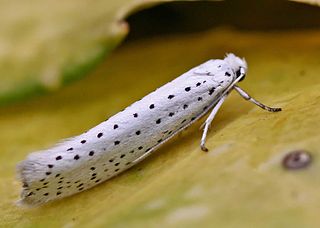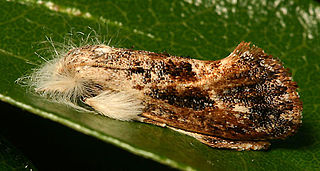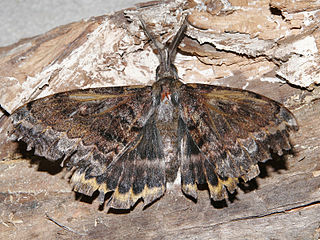
Moths are a group of insects that includes all members of the order Lepidoptera that are not butterflies. They were previously classified as suborder Heterocera, but the group is paraphyletic with respect to butterflies and neither subordinate taxon is used in modern classifications. Moths make up the vast majority of the order. There are approximately 160,000 species of moth, many of which have yet to be described. Most species of moth are nocturnal, although there are also crepuscular and diurnal species.

The family Yponomeutidae are known as the ermine moths, with several hundred species, most of them in the tropics. The larvae tend to form communal webs, and some are minor pests in agriculture, forestry, and horticulture. Adult moths are minor pollinators.

Grand Theft Auto: San Andreas is a 2004 action-adventure game developed by Rockstar North and published by Rockstar Games. It is the fifth main game in the Grand Theft Auto series, following 2002's Grand Theft Auto: Vice City, and the seventh entry overall. Set within the fictional state of San Andreas, the game follows Carl "CJ" Johnson, who returns home after his mother's murder and finds his old street gang has lost much of their territory. Over the course of the game, he attempts to rebuild the gang, clashes with corrupt authorities and powerful criminals, and gradually unravels the truth behind his mother's murder.

The Ditrysia are a natural group or clade of insects in the lepidopteran order containing both butterflies and moths. They are so named because the female has two distinct sexual openings: one for mating, and the other for laying eggs.

The Pyraloidea are a moth superfamily containing about 16,000 described species worldwide, and probably at least as many more remain to be described. They are generally fairly small moths, and as such, they have been traditionally associated with the paraphyletic Microlepidoptera.

Yponomeutoidea is a superfamily of ermine moths and relatives. There are about 1,800 species of Yponomeutoids worldwide, most of them known to come from temperate regions. This superfamily is one of the earliest groups to evolve external feeding and to colonize herbs in addition to shrubs and trees.

Gelechioidea is the superfamily of moths that contains the case-bearers, twirler moths, and relatives, also simply called curved-horn moths or gelechioid moths. It is a large and poorly understood '"micromoth" superfamily, constituting one of the basal lineages of the Ditrysia.

Gracillariidae is an important family of insects in the order Lepidoptera and the principal family of leaf miners that includes several economic, horticultural or recently invasive pest species such as the horse-chestnut leaf miner, Cameraria ohridella.

Acrolophinae is a family of moths in the order Lepidoptera. The subfamily comprises the burrowing webworm moths and tube moths and holds about 300 species in five genera, which occur in the wild only in the New World. It is closely related to the family Tineidae.

Anthelidae is a family of Australian lappet moths in the order Lepidoptera. It had earlier been considered to be part of the Lasiocampoidea superfamily, but a 2008 molecular phylogenetic study, supported by a 2011 study, resulted in reincluding the Anthelidae in the superfamily Bombycoidea.

Carposinoidea, the "fruitworm moths", is a superfamily of insects in the lepidopteran order. The superfamily is also known as Copromorphoidea, which is a junior synonym. These moths are small to medium-sized and are broad-winged bearing some resemblance to the superfamilies Tortricoidea and Immoidea. The antennae are often "pectinate" especially in males, and many species of these well camouflaged moths bear raised tufts of scales on the wings and a specialised fringe of scales at the base of the hindwing sometimes in females only; there are a number of other structural characteristics. The position of this superfamily is not certain, but it has been placed in the natural group of "Apoditrysia" "Obtectomera", rather than with the superfamilies Alucitoidea or Epermenioidea within which it has sometimes previously been placed, on the grounds that shared larval and pupal characteristics of these groups have probably evolved independently. It has been suggested that the division into two families should be abandoned.

Cimeliidae, the gold moths, is a family of moths that is now placed in the macroheteroceran superfamily Drepanoidea, although previously placed in its own superfamily. Uniquely, they have a pair of pocket-like organs on the seventh abdominal spiracle of the adult moth which are only possibly sound receptive organs. They are quite large and brightly coloured moths that occur in southern Europe and feed on species of Euphorbia. Sometimes they are attracted to light. The family was first described by Pierre Chrétien in 1916.

Eupoecilia ambiguella, the vine moth or European grape berry moth, is a Palearctic moth species of the family Tortricidae. It was first described in 1796 by Jacob Hübner. It is an economically significant grape pest species.

The Obtectomera is a clade of macro-moths and butterflies, comprising over 100,000 species in at least 12 superfamilies. This clade was initially defined by a pupal stage with the four anterior abdominal segments fused and immobile as the sole synapomorphy, but was later revised to include the modification of the dorsal edge of the pulvillus with a protrusion in the adult.

The Phycitinae are a subfamily of snout moths. Even though the Pyralidae subfamilies are all quite diverse, Phycitinae stand out even by standards of their family: with over 600 genera considered valid and more than 4000 species placed here at present, they unite up more than three-quarters of living snout moth diversity. Together with the closely related Epipaschiinae, they are apparently the most advanced lineage of snout moths.
Microcrambus discludellus is a moth in the family Crambidae. It was described by Heinrich Benno Möschler in 1890. It is found in the Dominican Republic, Puerto Rico and Colombia, as well as in North America, where it has been recorded from Florida and South Carolina.
Palpita kimballi, or Kimball's palpita moth, is a moth in the family Crambidae. It was described by Eugene G. Munroe in 1959. It is found in North America, where it has been recorded from Alabama, Florida, Georgia, Louisiana, North Carolina, Oklahoma, South Carolina, Tennessee and Virginia.

Pilocrocis ramentalis, commonly known as the scraped pilocrocis moth, is a species of moth in the family Crambidae. It was described by Julius Lederer in 1863. It is found in North America, where it has been recorded from Ontario to Florida and from Wisconsin to Texas. Further south. it is found in Mexico, Honduras, Costa Rica, Cuba and Puerto Rico. It is an introduced species on the Galápagos Islands. The habitat consists of open woods, clearings and damp areas.

Akito Y. Kawahara is an American and Japanese entomologist, scientist, and advocate of nature education, and the son of the modern conceptual artist On Kawara.
The Macroheterocera are a well supported clade of moths that are closely related to butterflies and macro-moths.
















